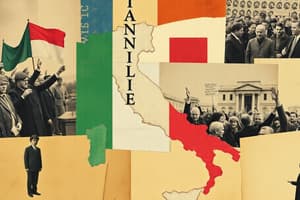Podcast
Questions and Answers
What was a key factor driving unification movements in 19th-century Europe?
What was a key factor driving unification movements in 19th-century Europe?
- Economic interests (correct)
- Historical grievances and trauma
- Clash of cultural and national identities
- Competition for resources and power
What are the three key characteristics of fascist ideologies?
What are the three key characteristics of fascist ideologies?
Nationalism, Authoritarianism, Militarism
Fascist ideologies emphasize individual rights and freedoms.
Fascist ideologies emphasize individual rights and freedoms.
False (B)
The Yugoslav Wars (1991-2001) were a series of ethnic conflicts between ______, Croats, Bosniaks, and others.
The Yugoslav Wars (1991-2001) were a series of ethnic conflicts between ______, Croats, Bosniaks, and others.
What is one of the consequences of Brexit?
What is one of the consequences of Brexit?
Match the following fascist leaders with their respective countries:
Match the following fascist leaders with their respective countries:
National identity is always exclusive, emphasizing ethnic or racial purity.
National identity is always exclusive, emphasizing ethnic or racial purity.
What are the two types of national identity?
What are the two types of national identity?
The Basque Conflict (1959-2011) was a separatist movement in the Basque region of ______ and France.
The Basque Conflict (1959-2011) was a separatist movement in the Basque region of ______ and France.
Study Notes
Unification Movements
- 19th-century Europe saw a wave of unification movements, aiming to unite fragmented territories under a single nation-state
- Examples:
- Italian Unification (1815-1871): led by Giuseppe Garibaldi and Camillo di Cavour, resulting in the Kingdom of Italy
- German Unification (1815-1871): led by Otto von Bismarck, resulting in the German Empire
- Key factors driving unification movements:
- Economic interests: creating a larger, more competitive market
- Cultural and linguistic ties: shared identity and language
- Political stability: reducing fragmentation and conflict
Ethnic Conflicts
- Ethnic conflicts in Europe often stem from competing national identities and territorial claims
- Examples:
- Yugoslav Wars (1991-2001): ethnic conflicts between Croats, Serbs, Bosniaks, and others led to the dissolution of Yugoslavia
- Basque Conflict (1959-2011): separatist movement in the Basque region of Spain and France
- Factors contributing to ethnic conflicts:
- Historical grievances and trauma
- Competition for resources and power
- Clash of cultural and national identities
Fascist Ideologies
- Fascist ideologies emerged in early 20th-century Europe, emphasizing national superiority and authoritarian rule
- Key characteristics:
- Nationalism: emphasizing the importance of the nation-state
- Authoritarianism: suppressing individual rights and freedoms
- Militarism: glorifying the military and promoting aggressive expansion
- Notable fascist leaders:
- Benito Mussolini (Italy)
- Adolf Hitler (Germany)
National Identity
- National identity refers to a shared sense of belonging and loyalty to a nation-state
- Factors shaping national identity:
- History and cultural heritage
- Language and education
- Shared values and myths
- National identity can be inclusive (emphasizing civic values) or exclusive (emphasizing ethnic or racial purity)
Brexit
- Brexit refers to the United Kingdom's withdrawal from the European Union (EU) in 2020
- Reasons for Brexit:
- Sovereignty: regaining control over laws and borders
- Immigration: reducing immigration from EU countries
- Economic concerns: reducing EU contributions and pursuing independent trade policies
- Consequences of Brexit:
- Economic uncertainty and potential trade barriers
- Changes to immigration policies and border control
- Impact on the EU's unity and stability
Unification Movements
- 19th-century Europe experienced a wave of unification movements aiming to unite fragmented territories under a single nation-state
- Italian Unification (1815-1871) was led by Giuseppe Garibaldi and Camillo di Cavour, resulting in the Kingdom of Italy
- German Unification (1815-1871) was led by Otto von Bismarck, resulting in the German Empire
- Economic interests, cultural and linguistic ties, and political stability were key factors driving unification movements
Ethnic Conflicts
- Ethnic conflicts in Europe often stem from competing national identities and territorial claims
- Yugoslav Wars (1991-2001) involved ethnic conflicts between Croats, Serbs, Bosniaks, and others, leading to the dissolution of Yugoslavia
- Basque Conflict (1959-2011) was a separatist movement in the Basque region of Spain and France
- Historical grievances and trauma, competition for resources and power, and clash of cultural and national identities contribute to ethnic conflicts
Fascist Ideologies
- Fascist ideologies emerged in early 20th-century Europe, emphasizing national superiority and authoritarian rule
- Key characteristics include nationalism, authoritarianism, and militarism
- Notable fascist leaders include Benito Mussolini (Italy) and Adolf Hitler (Germany)
National Identity
- National identity refers to a shared sense of belonging and loyalty to a nation-state
- History and cultural heritage, language and education, and shared values and myths shape national identity
- National identity can be inclusive (emphasizing civic values) or exclusive (emphasizing ethnic or racial purity)
Brexit
- Brexit refers to the United Kingdom's withdrawal from the European Union (EU) in 2020
- Reasons for Brexit include regaining sovereignty, reducing immigration from EU countries, and pursuing independent trade policies
- Consequences of Brexit include economic uncertainty, changes to immigration policies and border control, and impact on the EU's unity and stability
Studying That Suits You
Use AI to generate personalized quizzes and flashcards to suit your learning preferences.
Description
Explore the wave of unification movements in 19th-century Europe, including Italian and German unification, and the key factors driving these movements. Test your knowledge of this pivotal period in European history!




